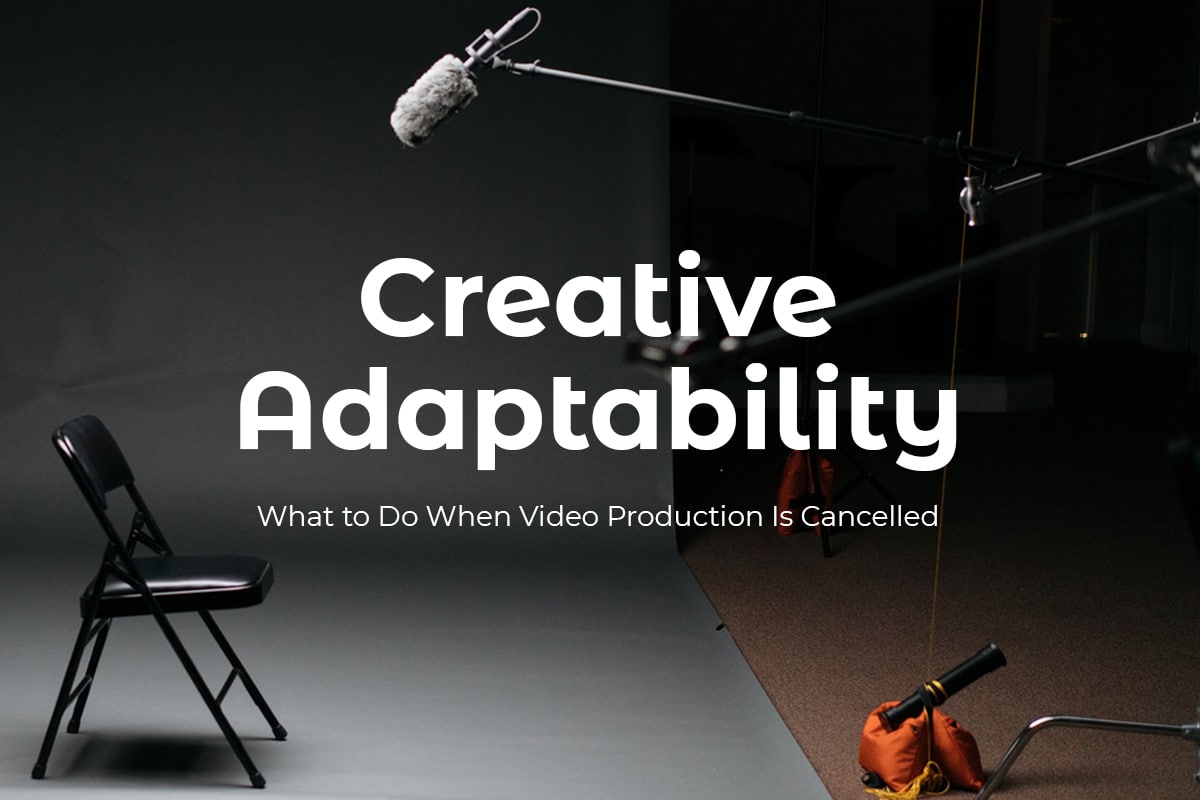5 Tips For When Video Production Is Cancelled
Get news & insights direct to your inbox.
Our 5 tips for when video production is cancelled will help you keep the creative content coming, even when in-person shoots are not possible.
It seems as though every time we refresh our newsfeed we hear something new about a major event being canceled or postponed. Often, businesses will live-stream their events or repurpose event-specific content to use for the future. With the coronavirus pandemic taking the business world by surprise, all live events and video production shoots have been placed on hold until further notice.
Although we’ve had to put several productions on pause that doesn’t stop us from using other forms of creative outlets. Today we’re sharing 5 tips to leverage video during COVID-19 and what to do when your shoot has been canceled.
5 Tips For When Video Production Is Cancelled or Postponed:
1. Video Conferencing
Usage for video conferencing platforms such as Zoom has skyrocketed overnight, literally. Zoom has become the number one virtual meeting space for classrooms, offices, church services, and even happy hours. According to CNN, Zoom has emerged as the most downloaded app on the Apple App Store, repeatedly breaking its download records. On Monday, March 23, Zoom was downloaded 2.13 million times worldwide, up from 2.04 million the day before, according to app tracking firm Apptopia. Two months prior, the app had just under 56,000 global downloads in a day. If you’re not leveraging video conferencing platforms at this very moment, you’re losing out.
Zoom is a great tool to use as a means to produce video content. We have seen many businesses use the platform to host informative discussions, live explainer tutorials, and weekly mini-series. Zoom has features where you can record, edit, and produce more grassroots testimonials from the comfort of your own home. You can even play with the greenscreen feature on Zoom, allowing users to jazz up their backgrounds. The New Park team loves this feature because it allows businesses to have fun and incorporate their visual branding.
2. Repurpose Existing Video Content
This is the perfect time to spring clean your in-house content. Tap into your library of previously shot video content and make necessary changes to adapt messaging for today. Editing, voiceover recording, and animation are all activities that can be done remotely and from the safety of a home studio.
Putting production and events on the back burner makes this is the perfect time to revisit content, pick up where you left off on a project, or use this time to brainstorm for future projects.
3. Use Animated Videos
All face-to-face communication has been canceled until further notice, but that shouldn’t stop you from using your creativity and communication in other outlets. Pivot your creative concept to rely more heavily on animation, stop motion videos, whiteboard, or explainer videos. The creative concepts remain the same but the way you communicate them changes.
We recommend changing and adapting your messaging to be direct, open, and timely. This is a very sensitive time for conducting business online, therefore be mindful of your wording.
4. Embrace Live-Streaming
Going live is the most engaging way to connect with your audience. Live video gets more likes, shares, comments, and clicks than any other form of video content! It’s the perfect way to share what’s happening in real-time, answer questions, share resources, and inspire conversation. We need community more than ever right now and live video provides the perfect platform to connect.
5. Explore New Platforms
If video content has been a part of your strategy in the past, this is a great time to explore how leveraging video on new platforms may bolster your exposure. Instagram TV (IGTV) allows Instagram users to create channels where they can upload videos between 15 seconds and 10 minutes long. IGTV exists so users can create more compelling content to engage their audience. Since engaging content is what social media is all about, IGTV is worth checking out.
If you’re not already, consider uploading video to your Google My Business page, LinkedIn profile, or any other platform that allows this type of content to appear within a profile. Uploading natively to social already? Repurpose those videos on a Youtube or Vimeo channel.
Consider reposting older videos to highlight content that’s still relevant and that your audience hasn’t seen in a while. If your audience has grown, this will be fresh content for your newer followers. Adding hashtag #TBT (throwback Thursday) is a great way to re-share some of those vintage posts!
Video will never go out of style.
Using video for storytelling has given us the ability to connect in ways like never before. It’s no wonder 100M internet users watch online videos every day. In times of uncertainty, there’s no telling what the future of business will look like but we know that video will continue to prevail.
[vcex_divider color=”#dddddd” width=”100%” height=”1px” margin_top=”20″ margin_bottom=”20″]
Ready to take your video marketing to the next level? Let’s Chat!
